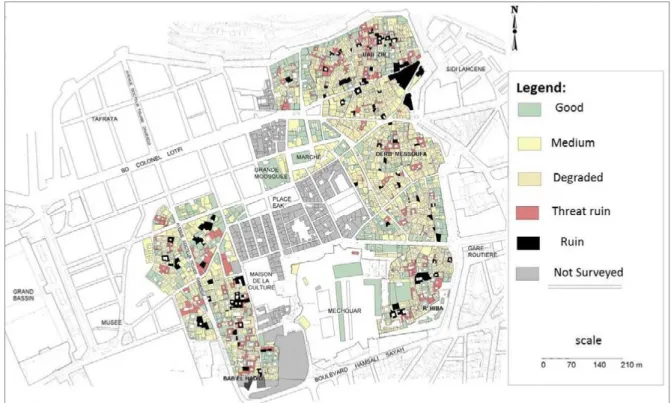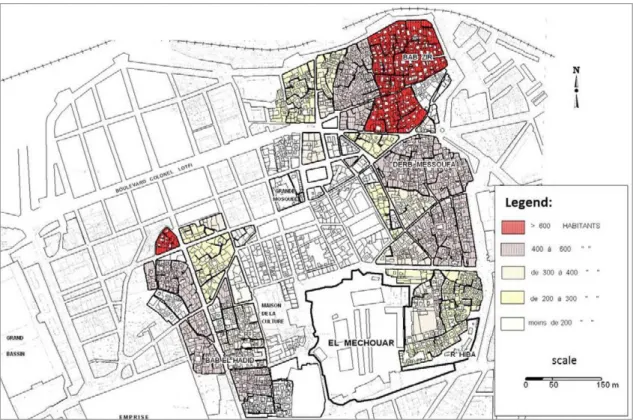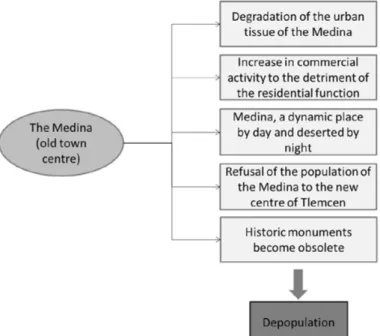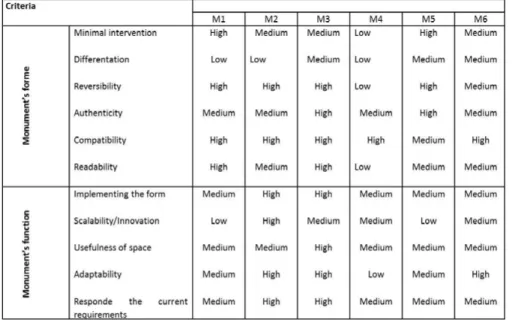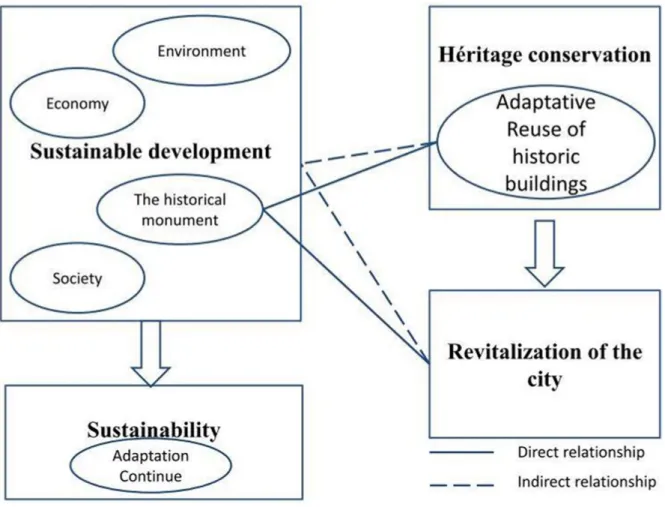ArcHistoR EXTRA 7 (2020)
www.archistor.unirc.it
ISSN 2384-8898 Supplemento di ArcHistoR 13/2020
a cura di Annunziata Maria Oteri Giuseppina Scamardì
u n pa e s e c i v u o l e
Studi e prospettive per i centri abbandonati e in via di spopolamento
o n e n e e d s a t o w n
S t u d i e s a n d p e r s p e c t i v e s f o r a b a n d o n e d o r d e p o p u l a t e d s m a l l t o w n s
ISBN 978-88-85479-09-8
L’attuale composizione urbana della città di Tlemcen è il risultato di una complessa evoluzione della città rispetto al centro storico. Questi cambiamenti, determinati da ragioni economiche, sociali, culturali, e politiche, hanno causato flussi migratori e di spopolamento dalla Medina (centro storico) che rappresenta lo spazio identitario degli abitanti di Tlemcen e conserva il patrimonio architettonico più antico della città, inclusi i monumenti storici che necessitano di interventi di conservazione e rigenerazione urbana. L’evento “Tlemcen, capitale della cultura islamica” ha avviato un significativo processo di riuso dei monumenti storici in musei.
Il presente studio mira a comprendere l’impatto della strategia di riuso dei monumenti storici come contributo al fenomeno dello spopolamento della Medina di Tlemcen, riflettendo sulla sostenibilità di questi interventi in relazione tanto agli aspetti conservativi, quanto a quelli
socio-economici.
Questo lavoro si è basato su un approccio empirico che incrocia i dati riferiti al processo di spopolamento, con quanto emerso dalla letteratura sul tema e dall’osservazione in situ.
Adaptive reuse: una strategia sostenibile per la rivitalizzazione della città. il caso dei monumenti riconvertiti a museo nella città di Tlemcen
Imane Djebbour (Tahri Mohamed Bechar University, Algeria), Ratiba Wided Biara (Tahri Mohamed Bechar University, Algeria)
o n e n e e d s a t o w n
S t u d i e s a n d p e r s p e c t i v e s f o r a b a n d o n e d o r d e p o p u l a t e d s m a l l t o w n s
Adaptive Reuse a Sustainable Strategy for the
Revitalization of the City: the Case of Monuments
Reconverted to Museums in the City of Tlemcen, Algeria
Imane Djebbour, Ratiba Wided BiaraHeritage buildings are the elements that convey values, making it possible to go back in time and read the civilizational succession that the city welcomes. However, a compelling obligation arises in order to preserve this heritage that is representative of people’s identity. As a result, there are many actions to take charge of the architectural heritage; they all aim to restore it to its best state1,
trying to find, proper, new functions in the present time. In fact, adaptive reuse is the most effective way to increase the life expectancy of a building by improving both of the physical and functional character, which systematically generates its durability2. Indeed, the reuse of the monument
reinforces the perceived image of the city and its territory, it is only through historic buildings that the city regains a resonance beyond its borders, which systematically generates a better economic gain and an attractiveness par excellence3. Nevertheless, architectural conservation takes on the
ambition of waiting for urban regeneration and sustainability4 and those through duality between
heritage and sustainable development. This decision must be based on an analytical and scientific method in order to create a homogeneity between the established project and all the economic,
1. Radiziszewska, Sladowski 2014. 2. Ijla, Broström 2015.
3. Grazuleviciuté 2006.
social and environmental requirements5. Typically, the event “Tlemcen capital of Islamic culture”
gave the opportunity to project a reuse of a set of monuments, almost all of which are converted into museums. These interventions seem to combine a balance between the form, function and attractiveness of the city in a global context of “sustainability”, hence the ambition to understand how these converted monuments constitute one of the major generators for the revitalization of the city, notwithstanding, the changing needs of society, economic interest and of the increasing progression of the shape of the city. To do this, this study is based on an empirical approach allowing an investigation on the ground through a semi-structured interview that collected the opinions of the people regarding the influence of the project of adaptive reuse of obsolete monuments on the dynamics of the city. Also an analysis of the documents including the historical evolution of the monuments studied. Finally, an in-situ observation was carried out to verify the contribution of the new use on the old form.
Presentation of Tlemcen city
Tlemcen is located in the far northwest of Algeria, it occupies a strategic position within the Mediterranean countries and the African continent. It was the capital of the central Maghreb at the time of Zianide. This city is crossed by different civilizations, which are: Berbers, Phoenicians, Romans, Arabs, Muslim Berber dynasties, Spanish, Turks and French. At that time a religious, cultural and architectural center by excellence, this city today contains preponderant historical remains, including a large percentage of the Arab-Islamic heritage, the reason why Tlemcen was designated by ISESCO (The Islamic Educational, Scientific and Cultural Organization) as the “Capital of Islamic Culture in 2011”.
The current urban composition of the Tlemcen city is the result of a divergent evolution from an old centre to other new nuclei presenting the new city (fig. 1).
This study focuses on the Medina, a former city centre, which has undergone direct and indirect changes in urban development since the French occupation, initially referring to new economic, social, cultural and political references. Despite this transformation process, the medina has retained a certain spatial and functional coherence, although a large number of buildings have lost their original function and are currently of little interest to the needs of the new city.
Adaptive Reuse
Figure 1. Stage of the city’s urban growth (Background Map Revision study of the PDAU of the Tlemcen-Mansourah-Chetouane group, ANAT “National Land Management Agency”).
The functional analysis of the former city centre shows the importance of commercial activity to the detriment of the residential function. More than 800 premises have been created in recent years, the nature of which is a daily necessity for the population of Tlemcenien. At the same time, Aboriginal artisanal activities are becoming increasingly rare. Indeed, this phenomenon is explained by the profitability of trade in relation to housing in the old centre of this city. This has made the Medina a daytime activity centre unlike at night, the place becomes desert and has no soul.
As for the state of housing (fig. 2), it is increasingly experiencing degradations that are leading to the overcrowding of the Medina and intra-urban migration in areas that have become new centres of residential and even commercial interest.
Figure 2. State of the built context of the old town center of Tlemcen (Medina) (ANAT “National Land Management Agency”/Field survey 1998).
Adaptive Reuse
However, the small percentage of the habitat remaining in the old centre in good condition, the population residing in the Medina has increased from 14955 inhabitants to 8851 inhabitants, i.e. a loss of about 6000 inhabitants, and this has begun since 1966 (fig. 3). This decline can be explained by the advanced deterioration of houses, which has significantly reduced the stock of habitable housing: 106 buildings in ruins and 147 threatening to be destroyed.
At the same time, the population is multiplying, its needs and the demand for its services are overwhelming the capacity of permanent structures such as mosques, town halls, mederssas, royal palaces of the past (case study of this work). As a result, these heritage buildings are becoming obsolete and no longer present a point of attractiveness and usefulness of Tlemcen’s society, as was
the case in the past, but they currently form an integral part of the historic monuments, symbols of the city’s and its society’s identity. Indeed, these historical monuments present one of the major causes of the depopulation of the Medina of Tlemcen (fig. 4).
Events, a dynamic asset for the city
The event is a contribution of a dynamic that has allowed a city to approve its culture and to highlight its tangible and intangible heritage6. He has made Tlemcen an object of programming in
order to break the decadence that is being created due to socio-economic changes as well as the historical mutations of the region.
In order to prepare the event, numerous works have been launched, citing the restoration and development work on the old town of Tlemcen initiated in 2009, the development of the alleys
6. Garnier 2002.
Figure 4. Summary diagram of the aspects of the depopulation of the old center (elaboration by the authors).
Adaptive Reuse
Figure 5. Historic sites and monuments of the Medina of Tlemcen (O.G.E.B.C “National Office for the Management and Exploitation of Cultural Property”).
and derbs, and the renovation of the facades. At the same time, the advent of the event “Tlemcen, capital of Islamic culture, 2011” made it possible to initiate the historic center as a protected area (fig. 5). Also, this opportunity made it possible to highlight a good number of historic buildings, some of which still retain their primary functions while others have become obsolete, which has enabled them to accommodate new functions. This event made it possible to reuse these monuments, almost all of which are intended for the Museum function.
This research focuses on these historical monuments converted into museums, which are located mainly in the heart of the city’s historic centre, from which they come from different historical periods (Zyanid, Merinid, French). These monuments are of various typologies: mosques, medersas, royal palaces and town halls (fig. 6).
Adaptive Reuse
In the context of this research we try to answer the following question: What future do we imagine for these old buildings, which have historically played an important role in the civic consciousness of a community and which still contribute to forming the memory and cultural identity of a society through their new museum function? Can it be assumed that the recovery of abandoned buildings could be a virtuous practice, not only in terms of sustainability for their enormous potential, but also for the role that the centrality of public monuments can play in social revitalization and urban regeneration?
If one is convinced that a building does not gain its sustainability with the endowment of its current use, it is better to assign it a new function. The reuse of a monument is very encouraged if the installation of a new use allows the enhancement of the site’s architecture7. It differs from
other empowerment actions in the importance it gives to current standards and codes. Indeed, adaptive reuse is a method of extending the useful life of a building and therefore its durability through a combination of improvement and conversion8, it becomes an effective strategy to improve
the sustainability of existing buildings and revitalize the city life9. Citizens associate historic buildings
with meanings that underpin the sense of community and local identity and, therefore, safeguarding buildings has positive impacts and promotes living conditions that make cities safer and more livable. Consequently, a successful adaptation is one that respects the existing building and its historical context and adds a contemporary layer to the heritage building rather than destroying its character10.
Unquestionably, in the transformations that are taking place on the old building, two essential precepts are at the basis of any reflection: the shape of the existing building, and the new integrated function11.
However, the use and form figure interactive, one influences the other, only, the originality and architectural character of the building override the type of use in order to maintain the authenticity of the place for future generations12. As a result, the conversion will only be successful under the
following conditions:
7. Elsorady 2014. 8. Ijla, Broström 2015. 9. Douglas 2006.
10. DEH 2004; Ijla, Broström 2015. 11. Begert, Dini 2003.
- The established program must respond to a real need. - The new function enhances the existing.
- The existing enhances the new use.
The following table presents all the criteria obtained (Table 1), allowing a structured evaluation to measure the degree of compatibility of the form with its new use. This allows us to conclude the influence of the adaptive reuse project of a historic monument on its urban environment, on the community as well as on the economic component of the region. This research work is based on the empirical method, allowing direct investigations to be carried out in the field to draw the necessary conclusions. First, a semi-directive interview was conducted with the interviewees (including heritage specialists, politicians and citizens of the city of Tlemcen), starting with an open-ended question and then reframing it with other recovery issues in order to directly target the main objective. The interview consists of two essential parts. The first part focuses on the formal aspect and the second part includes the functional aspect of the converted monument. Then the answers were sorted according to the scale of appreciation which is divided into ‘’Low’’, ‘’Medium’’, ‘’Strong’’ and finally discussed.
Then, the document analysis used the various plans, photos and diagnostic reports to discern the changes made to the monuments-museums. This was verified following an observational visit to the selected sites.
Table 1. Criteria of the form and function of the monument (elaboration by the authors).
Adaptive Reuse
Results and discussions
The survey reveals relevant realities about the conversion process and its likely projection into sustainability. The results obtained (fig. 7, Table 2) indicate a constant interaction between the old form and the new museum function. The ‘’Compatibility’’ criterion is the most successful in this adaptive reuse process (fig. 7), the condition of all monuments induces the success of physical and functional intervention operations. However, the new function ensures a “response to the new socio-economic” requirements of the city, without compromising the possibility of returning to the original functional character (reversibility) to the extent of the willingness to use. Similarly, the reuse implements the monument again through a “minimal intervention” which aims to “readapt the new function” without harming the authenticity of this historic monument. As a result, function and form complement each other in order to bring the old obsolete form back to life and reintegrate it into its current environment.
Figure 7. Degree of success of each criteria (elaboration by the authors).
Nevertheless, the degree of success of each criterion varies from one example to another, the former Sidi Belahcen Mosque (Table 2) and the former French Town Hall (Table 2) are the two most successful projects (Table 2) because of their strategic location in the heart of the old city, they present an attractive point emphasizing the urban regeneration of the historic centre which is losing its value following the spreading of the uncontrollable city, which has caused a shift in interest towards the new poles. The two museums currently in operation have succeeded in restoring the old structures without stating their authentic character. The museums are currently forming an economic refreshment well that has contributed to this desire to invite heritage enthusiasts to join the city of Tlemcen. Admittedly, the will of the inhabitants is sidelined when such decisions are taken to adaptively reuse monuments that are symbols of the community’s identity, but this has not prevented it from reacting perfectly to the city’s economic profit streams.
Unlike the reuse of the royal palace (Table 2) as much as a museum of traditional Algerian costume, it has not upgraded the old structure, whose degree of adaptability of the new function is very low (Table 2), which leads to a formal degradation of the monument. However, when compared to the
Table 2. Results of the evaluation of the form and function criteria of the monuments (elaboration by the authors).
Adaptive Reuse
rest of the museums, the old palace receives interesting flows of visitors, people find it the most attractive space because of its history and composition. As a result, the monument itself becomes a museum exhibition piece, which has not undergone any real formal adaptation, but has instead been reassigned for the new museum function. This is the case for all monuments reused in museums.
Truly, we are seeking, through the reuse of these monuments, a use that does not bring about any change in architectural form. The new function is chosen to adapt to the possibilities offered by the old building. Thus, monuments are more likely to be exhibited as a witness to the identity of the people and to restore the attractiveness of the old city where they are located.
Monuments converted into museums (Table 2) are one of the strategies adopted at the 2011 Capital of Islamic Culture event to exploit this heritage for properties that enhance the city’s attractiveness. Only such a fact can only regain its durability if it respects the norms of the present and the future without affecting the authenticity of the place.
This is in order to meet the city’s new requirements, to satisfy the needs of today’s society, and to contribute to the growth of the country’s economy13. However, complicity will be created
between the old form and the new use, they become complementary for the purpose of improving the functioning of the city (fig. 8). This would be the best way to proliferate the most valuable community resources, reduce land acquisition and construction costs decently, revitalize existing neighbourhoods and help control urban sprawl14. Therefore, the fact of preserving parts of cities as
a history and then reusing these spaces for various purposes is motivated by an increasing number of calls for urban regeneration.
Thus, the increase in the number of visitors to the Medina has progressed since the inauguration of the heritage works of the event “Tlemcen capital of Islamic culture 2011”. Thanks to the reuse of historic monuments as museums, the old town centre is gaining resonance beyond its borders (fig. 9). Tlemcen’s society is once again returning to its places of memory that have almost become useless. As a result, a new attractiveness is being created in the old centre, which has given new life to its spatial dynamics. However, the old centre of Tlemcen did not experience repopulation, i.e. the adaptive reuse of monuments was not the magic solution for the repopulation of the old centre, but it contributed to this desire to revive this area of the city’s identity. Rather, it is being transformed into a daytime activity space driven by commercial practice for local and international visitors and tourists.
13. Bullen, Love 2011b.
Adaptive Reuse
However, the issue of adaptive reuse of historic buildings is closely linked to the future of cities, it presents a complex process that requires that participants in the process clearly understand how to determine the most appropriate future for the building at a specific location and time. This decision should be based on an analytical and scientific method in order to find the most appropriate strategy for the adopted project. Otherwise, after some time, due to social and economic problems, heritage buildings may be decommissioned or abandoned again15.
The economic sustainability of heritage buildings makes it possible to benefit from the gains of its tangible and intangible values for the good of the country’s economy through the rejection of demolitions and rebuilding. Consequently, the adaptive reuse of historic buildings must ensure economic efficiency that adequately meets the requirements of design and reuse practices as well as operating and maintenance costs. The adaptive reuse of historic monuments in Tlemcen created jobs during the construction work and after the museums opened. This new function has also favoured the tourist attraction, and has generated economic returns through entry fees as well as for the trade placed on the site.
Consequently, the conservation and reuse of these can play an important role in the regeneration process and contribute to meeting the growing need for new buildings. It can also be argued that this
15. Misirlisory, Gunçe 2016.
type of adaptive reuse is a sustainable option as it promotes urban strengthening and encourages revitalization efforts. The benefits of increasing the number of historic buildings reused in older neighbourhoods or visitor centres are widely recognised, and it is strongly believed that this will contribute to achieving sustainability objectives16.
As part of a broader revitalization strategy to promote sustainability in the built environment, many buildings of cultural and historical importance are adapted and reused rather than demolished or abandoned17. This fact of reusing the monument strengthens the perceived image of the city
and its territory, it is only through these points of reference that the city gains resonance beyond its borders, which systematically generates a better economic gain and above all a revitalization of the identity of the people. This duality of heritage and sustainable development is absolutely clear (fig. 9): the preservation of cultural heritage ensures the environmental, cultural and economic sustainability of the city18.
Conclusion
Heritage buildings are perceived as a testimony to the identity and attractiveness of the place, they contribute to the improvement of urban development and the attractiveness of the city. The reuse of these buildings allows them to take their place in the current city. Indeed, this decision presents a lasting act that enhances the image of the city and its territory. However, the exploitation of this heritage in a need to promote the attractiveness of the city can only be achieved if it does not affect the local community, contributes to increasing the stolen economy and contributes to successful land planning. However, adaptive reuse represents a sustainable strategy by excellence and makes it possible to resume the functioning of the monument in one’s city in order to implement the potentialities of the heritage in the service of the development of one’s territory.
The event presents an unprecedented opportunity to change the state of things that exists with the ticket to review the programming of the indolence-free city, the first elements of which are the heritage buildings, a past that is still alive and a tangible element of the attraction of the place.
16. Ijla, Broström 2015. 17. DEH 2004.
Adaptive Reuse
Bibliography
Begert, Dini 2003 - D. Begert, C. Dini, Réflexions autour d’une transformation, Une fabrique de Pianos à Bienne, in Cahier1
éléments d’analyse, ENAC – Architecture 2003, pp. 4-46, http://archivesma.epfl.ch/2004/003/Enonc%C3%A9_d%C3%A9f.
pdf/ (ultimo accesso 27 marzo 2020).
Bullen, Love 2011a - P.A. Bullen, P.E.D. Love, A new model for the past: a model for adaptive reuse decision making, in «Built Environment Project and Asset Management», 2011, 1, pp. 32-44.
Bullen, Love 2011b - P.A. Bullen, P.E.D. Love, Factors influencing the adaptive reuse of buildings, in «Journal of Engineering. Design and Technology», 9 (2011), 1, pp. 32-46.
DEH 2004 - DEH, Adaptive reuse: Preserving our past, building our future, Department of Environment and Heritage, Canberra 2004.
Douglas 2006 - J. Douglas, Building Adaptation, Butterworth-Heinemann, Oxford 2006.
Elsorady 2014 - D.A. Elsorady, Assessment of the compatibility of new uses for heritage buildings: The example of
Alexandria National Museum, Alexandria, Egypt, in «Journal of Cultural Heritage», 15 (2014), 5, pp. 511-521.
Garnier 2002 - J.P. Garnier, Du monument comme “événement”, in «L’Homme et la société», 4 (2002), 146, pp. 7-29. Grazuleviciuté 2006 - I. Grazuleviciuté, Cultural Heritage in the Context of Sustainable Development, in «Environmental research, engineering & management», 3 (2006), 37, pp.74-79.
Ijla, Broström 2015 - A. Ijla, T. Broström, The Sustainable Viability of Adaptive Reuse of Historic Buildings: the experiences
of Two World Heritage Old Cities; Bethlehem in Palestine and Visby in Sweden, in «International Invention Journal of Arts
and Social Sciences», 2015, 2, pp. 52-66.
Marçais, Marçais 1903 - W Marçais, G. Marçais, Les monuments arabes de Tlemcen, Édition Fontemoing, Paris 1903. Misirlisory, Gunçe 2016 - D. Misirlisory, K. Gunçe, Adaptive reuse strategies for heritage buildings: A holistic approach, in «Sustainable cities and society», 2016, 26, pp. 91-98.
Radiziszewska, Sladowski 2014 - E. Radiziszewska, G. Sladowski, Evaluation of historic building conversion options in the

